 |
|||||||||||
|
||
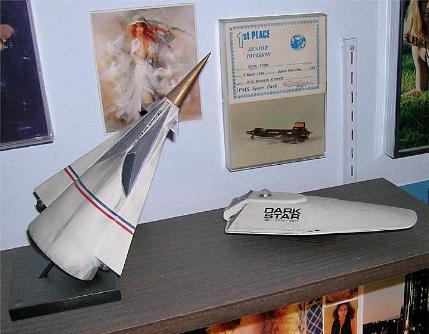 |
||||
This is the Icarus model I scratch-built many years ago sitting on my shelf next to the Dark Star.
The model was constructed in 1/48th scale using a central steel rod to get the proper sharp point for the nose. The remainder of the Icarus is a framework of plastic cross-sections, wrapped in an outer sheet plastic skin, which ends in a gold nose cone. The cone itself is built up with modeling putty and sanded to the correct shape to blend between the final cross section and the steel tip. The rod extends all the way through the spacecraft and is used to support the model on its base. |
||||
— The Story Behind the Spacecraft Name — |
||
When "Planet of the Apes" was first released in 1968, the opening sequence featured one of the most beautifully-designed spacecraft ever seen in a motion picture. The simple, yet dramatic lines captured the imagination of many people, including myself. Several years later, in high school, I met a fellow afficiando of this vehicle, Phil Broad. He and I spent hours working on various drawings in an attempt to capture the design of the ship from our memories. Finally, we found not only photos, but Phil was able to obtain a set of blueprints from the studio.
I turned my limited artistic skills to making a set of my own blueprints, part of a set which also included the Proteus from "Fantastic Voyage," and later the Dark Star from the movie of the same name. As I learned in a mechanical drawing class in school, I needed to have a title block for the blueprint, and when it came time to do this for the ship from "Planet of the Apes" I realized there was never a name given in any of the three movies, or the TV series, in which it appeared.
Considering the fact that at least two of these vehicles had unsuccessful missions (The Taylor and Brent missions from the first two movies), the idea formed that maybe the name should reflect this idea of reaching too high and falling to Earth. This line of thought led me quickly to the name Icarus from the Greek legend.
As a science fiction fan I was a customer of a company called Star Tech. I became friends with the man who ran Star Tech, and it turned out that through a barter program between the two of us, he ended up selling copies of my science fiction vehicle blueprints. It wasn't until many years later that I found a model of the Apes ship from, I believe it was, Lunar Models. When I saw the name Icarus on the box art, my immediate reaction was that somehow they had gone down the same road I had, and by pure happenstance had come up with an identical name to the one I used to christen the ship all those years ago. When I talked with Phil about this, he explained that, no, this was my name, which had now entered the lexicon because of those blueprints from Star Tech.
I am extremely honored to be included in even this tiny way with regard to the "Planet of the Apes" saga. And it was wonderful to have the name Icarus acknowledged briefly in the 2011 movie "Rise of the Planet of the Apes," which has now placed the name officially into the canon of the Apes universe.
Immediately below are scans of the blueprints I created which bore the original name of Icarus. Although still somewhat rough, these are the second set I drew, replacing my original drawings from 1972 with these larger and more accurate pencil drawings completed on 25 and 26 July 1975. |
|||||
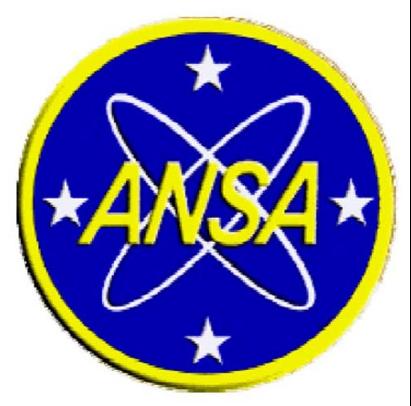 |
|||||
Often thought of as an alternative space agency to NASA, one fan suggested a different reason for the logo considering the intersteller and supra-lightspeed aspect of the program Advanced Nuclear Stellar Acceleration Project |
|||||
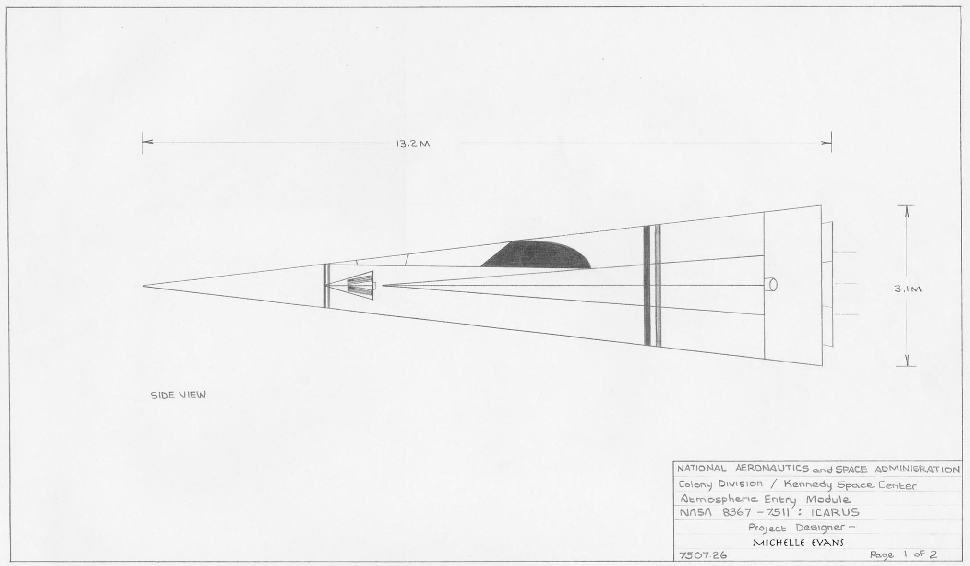 |
||
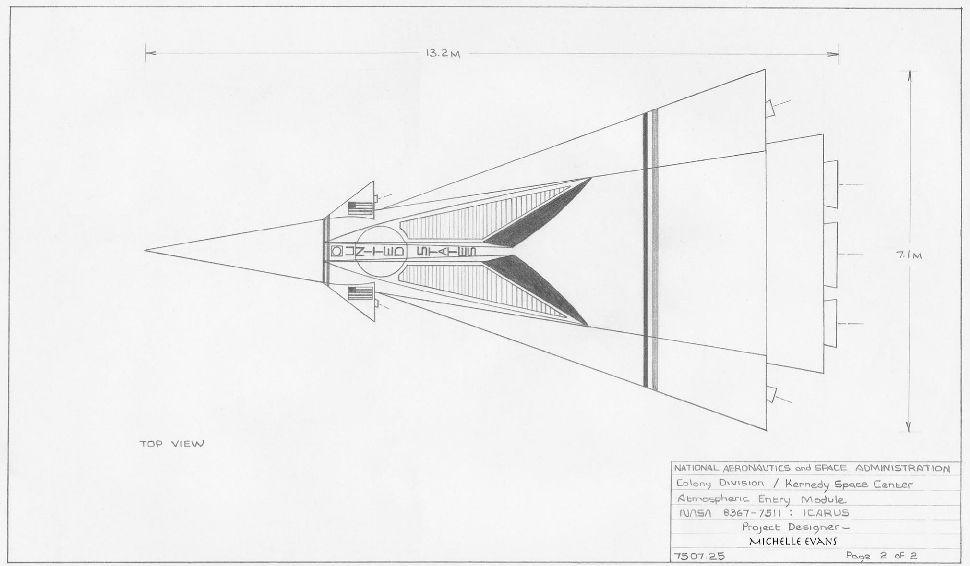 |
||
— Entering "Planet of the Apes" Canon — |
||
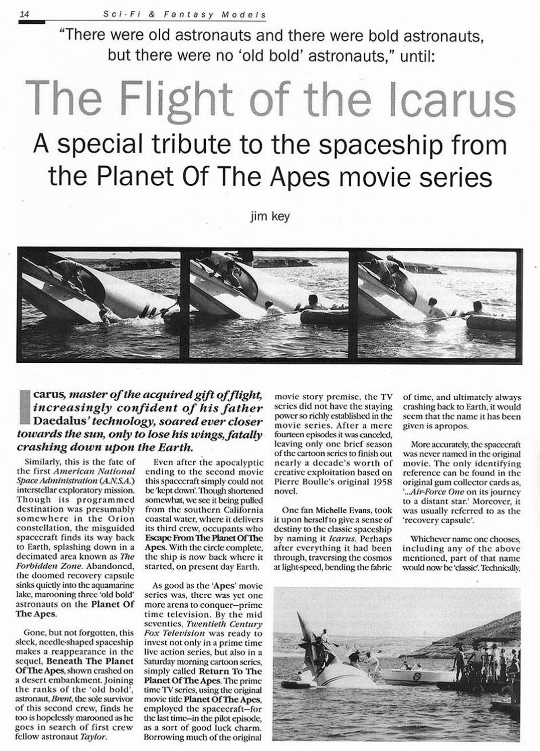 |
On 21 July 1999 issue # 38 of Sci-Fi & Fantasy Models International published an article by Jim Key in tribute to the Icarus. In this article I am mentioned for the first time as the creator of the spacecraft name. It is located in the first line of the second paragraph in column 3.
"One fan, Michelle Evans, took it upon herself to give a sense of destiny to the classic spaceship by naming it Icaurus. Perhaps after everything it had been through, traversing the cosmos at light speed, bending the fabric of time, and ultimately always crashing back to Earth, it would seem the name it has been given is apropos." |
|||
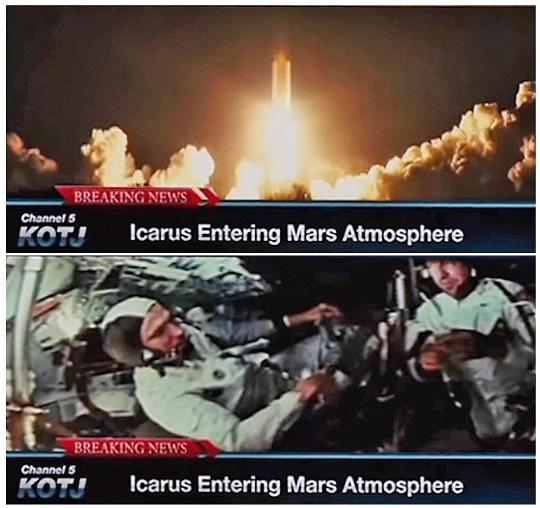 |
||||
In the 2011 motion picture "Rise of the Planet of the Apes" the Icaurus mission is mentioned in news reports. Above are a couple of images from a TV news spot, then later a newspaper headline is seen saying that the Icarus has gone missing. |
||||
— Origin of the Icarus Spacecraft — |
||
The spacecraft seen in the original "Planet of the Apes" never received a name on screen. It went through several iterations in pre-production before finally emerging as the elliptical stiletto seen in the first film in the Apes franchise. |
||
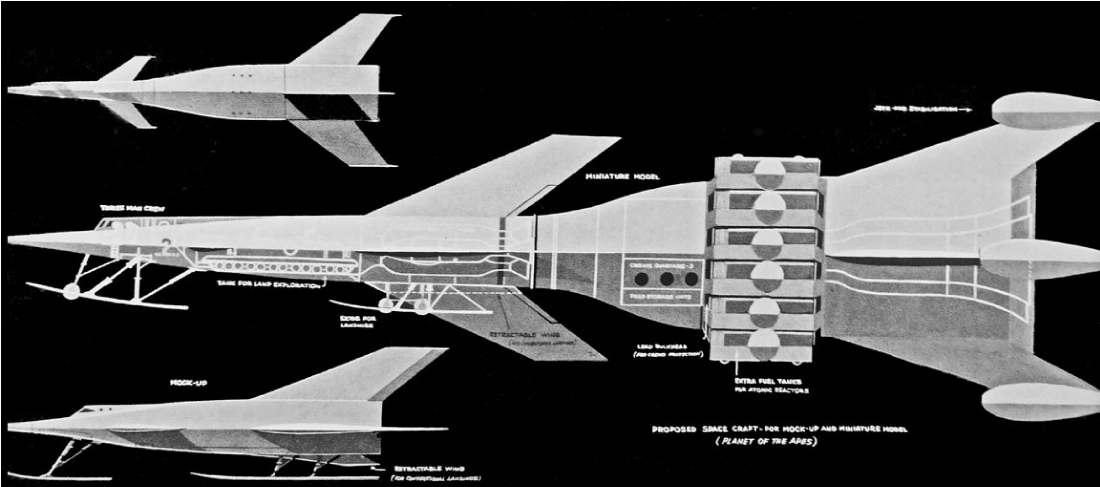 |
||
The original plan for the Icarus was to have a massive spacecraft with a propulsion module that would be left in orbit, while the descent craft would enter the atmosphere and land on the alien planet. Note the undercarriage that included both skids and wheels for landing on various types of terrain. Unfortunately, no provision was made for a water landing. |
||
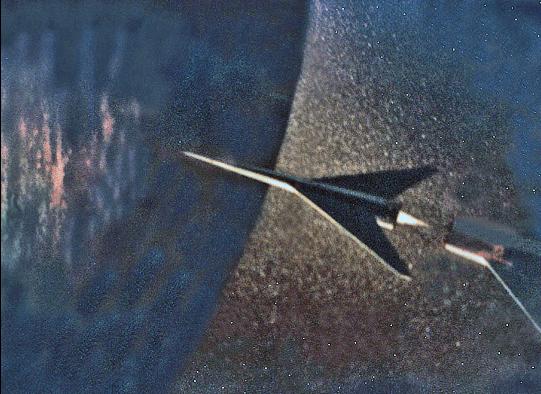 |
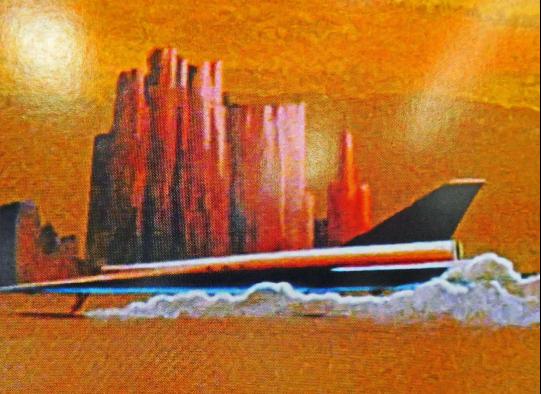 |
|||
The Icarus descent module separates from the main spacecraft. It is a very early rendering, and I have never seen this image reproduced in any publication. I found it in the Universal Studios gift shop in a display in the late 1970s, and grabbed a photo. |
The Icarus lands in the desert landscape of the Forbidden Zone. This version has the rear-mounted swept wings, but not the T-tail of later iterations. Note that it apparently also has a set of three windows along the fuselage. |
|||
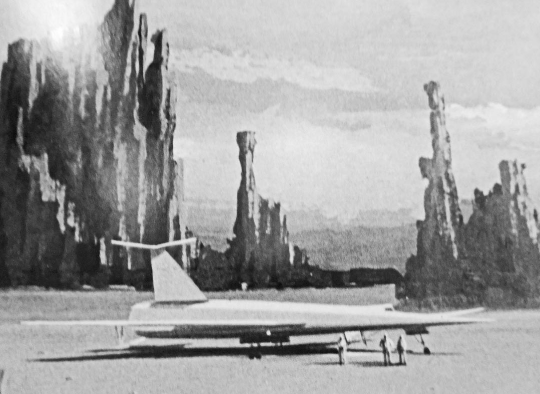 |
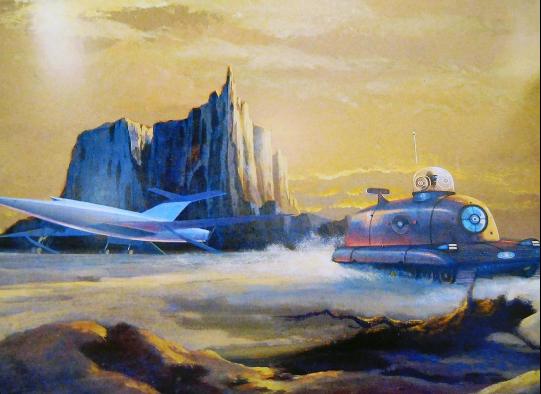 |
|||
The Icarus after landing. The three astronauts have stepped outside to check their surroundings. Much different than the crash landing we see in the film version. With the T-tail it now looks very similar to the Von Braun spaceplane design from the 1950s. |
The Icarus crew deploys a tank-like rover to explore their new world. Here the production designers are taking an idea seen in the television show "Lost in Space" which had the Chariot vehicle to take them about on the planetary surface. |
|||
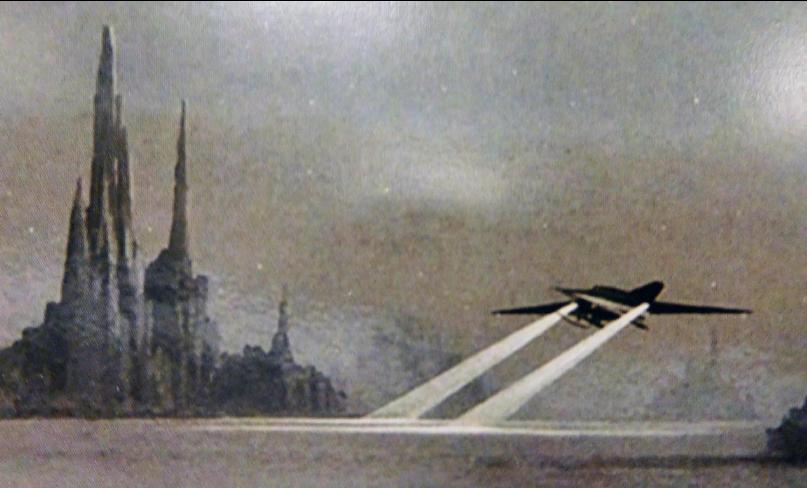 |
||
A dramatic scene as the Icarus comes in for a pre-dawn touchdown, with landing lights on and skids deployed. |
||
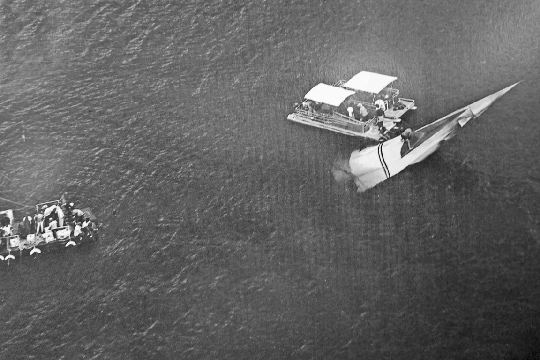 |
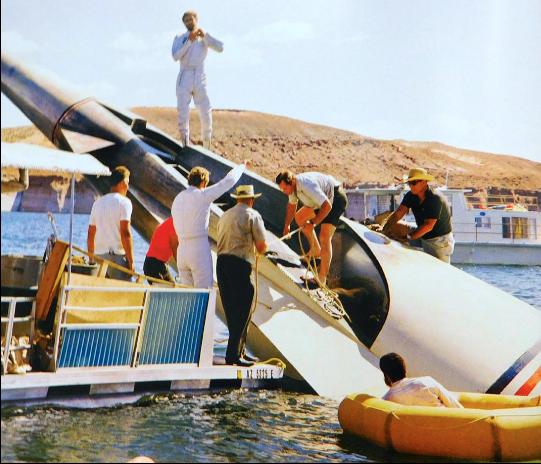 |
|||||
(Above and Right) The final version of the Icarus shown during filming on Lake Powell. An iconic design that will probably never be equalled.
The spacecraft prop was used in the original Planet of the Apes, Beneath the Planet of the Apes, Escape From the Planet of the Apes, in "The Long Rain" segment of the 1969 movie The Illustrated Man, and finally in the TV adaptation of Planet of the Apes, as a sign holder outside a hotel in Kanab, Utah, before finally being discarded. |
||||||
— Icarus Models — |
||
Several different companies have produced models based on the Icarus design. Lunar Models did one, which I believe was later picked up under the banner of Monsters in Motion. There was a diorama kit of the vehicle in the water, and some tiny versions that came in toys marketing figures from the movie.
I scratch-built three differnt versions myself. The final version is seen at the top of this page, along with some earlier balsa-wood renditions. This final version is based off the studio blueprints of what was actually built for the first movie. Other people have tried to expand on the basic spacecraft, most notably the amazing work of my great friend, Phil Broad, who is now unfortunately gone. Be sure to check out Phil's renderings here.
Probably the best kit I have seen out there is the one offered by Fantastic Plastic. |
||
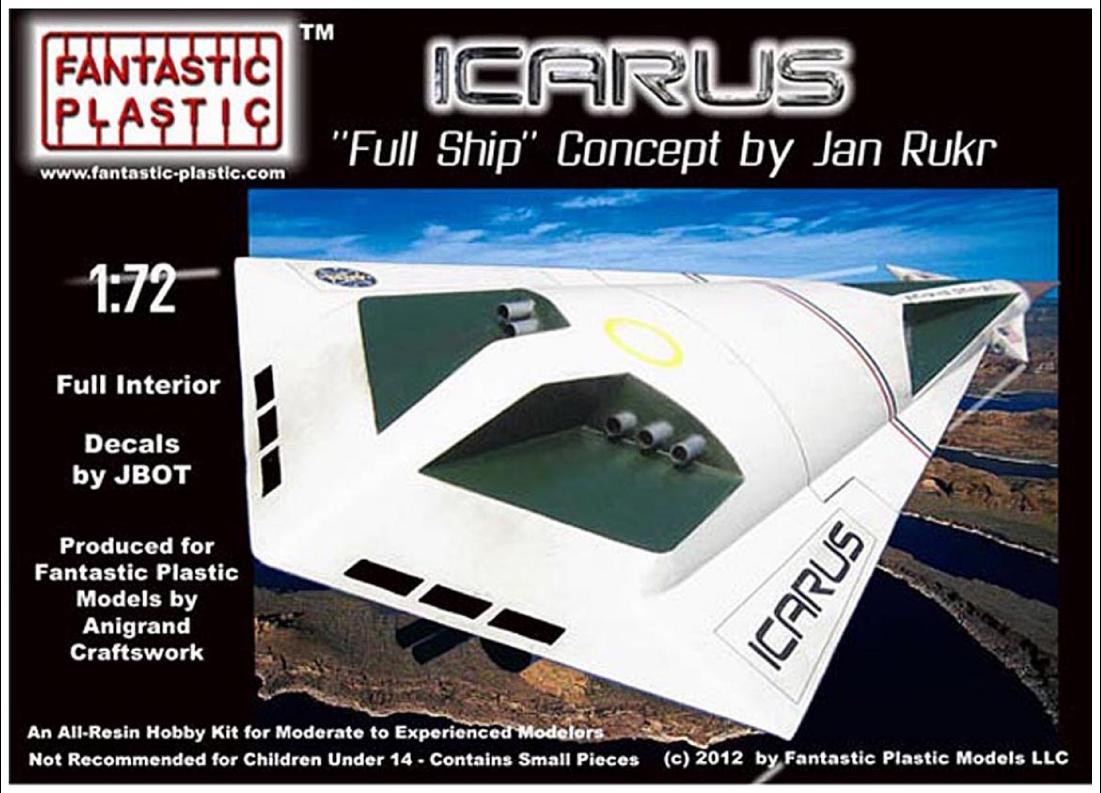 |
||
Box art for the Fantastic Plastic version of the Icarus created by Jan Rukr. |
||
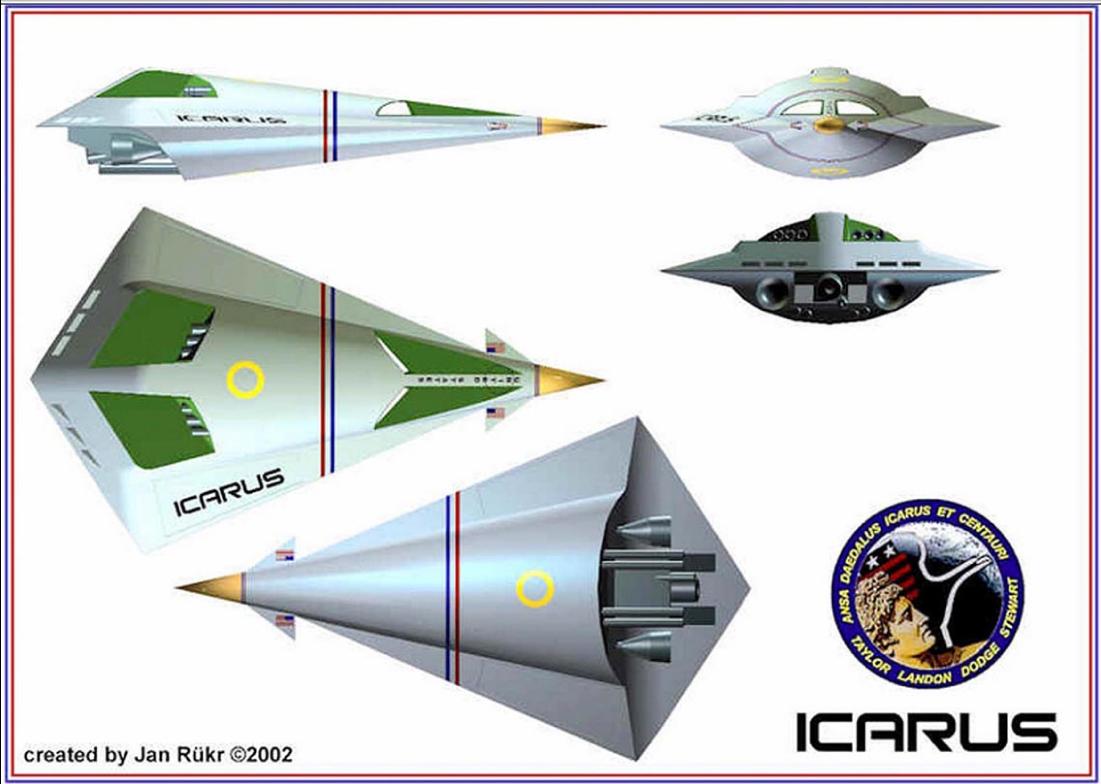 |
||
Great 5-view artwork showing the various aspects of Jan Rukr's design, with the hypothetical extended body beyond what was shown on screen. Note the mission emblem he also created, which uses the Apollo 17 patch as its basis. In this case the bottom has the four astronauts names of Taylor, Landon, Dodge, and Stewart. On the top are the words "ANSA Daedalus Icarus Et Centuari." |
||
— Personal Icarus Artwork — |
||
I did a lot of design work on the Icarus before I saw the blueprints. At first I did several variations based only on my memories. As I learned more, the designs evolved. I also then did sketches attempting to depict various stages of the spacecraft's mission, from construction, through launch, travel, entry, and crash landing. Here are some of my attempts, two of which were actually constructed. |
||
 |
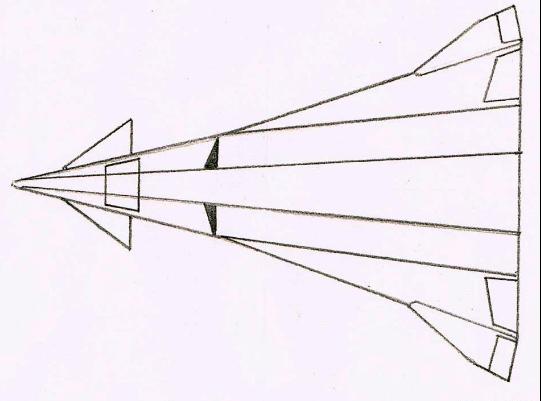 |
|||
Design 1: I built this first version of the Icarus out of balsa wood, and added a spare S-IVB stage from a Saturn V kit. (Below) I then envisioned it being sent to orbit on the back of a reusable booster. |
||||
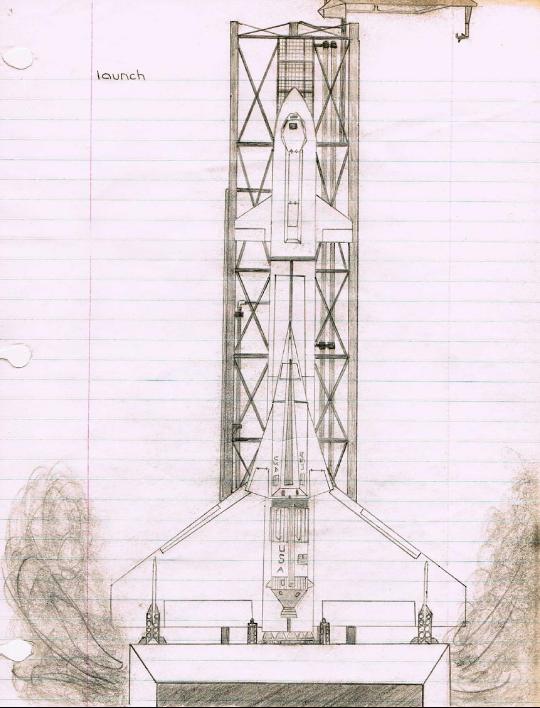 |
||||
Design 2: For the second version I actually constructed, I again used sheet balsa wood as it was easy to put together. Here I first envisioned a lifting body-type design. |
||||
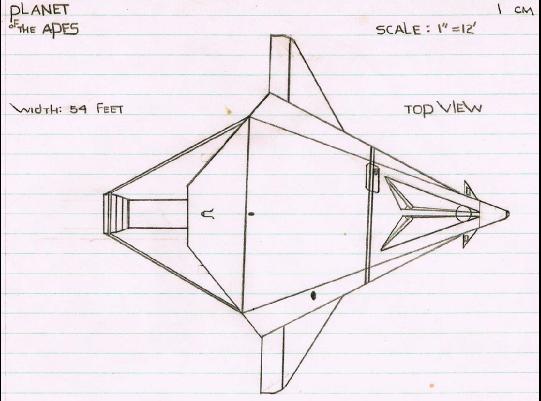 |
||||
Design 3: When I had the chance to again see the movie, I realized that the body was an ellipse, so this is the result of that redesign. I added the wings for atmospheric control (which could have been hidden under the water), along with an engine section that had a heat shield to protect the engine area during entry. The basic design was way too wide, but was starting to look like the real vehicle from the movie. |
||||
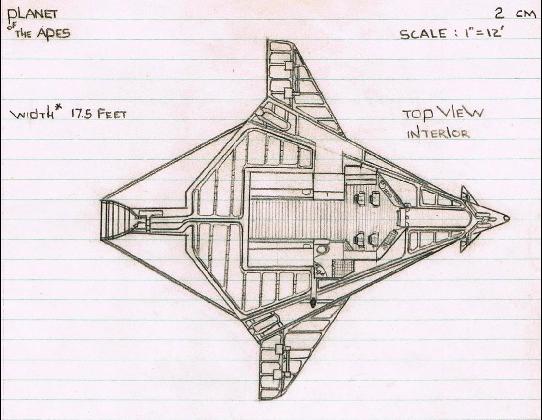 |
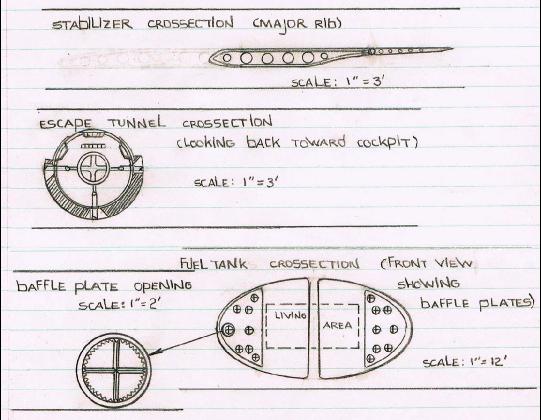 |
|||
Design 3: I went all out with this latest design by also doing numerous detail sheets, and even added an Orbital/Propulsion module for the first time. |
||
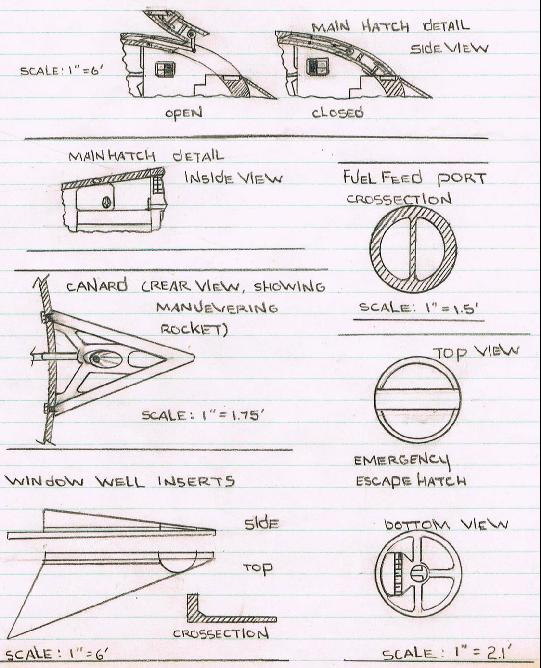 |
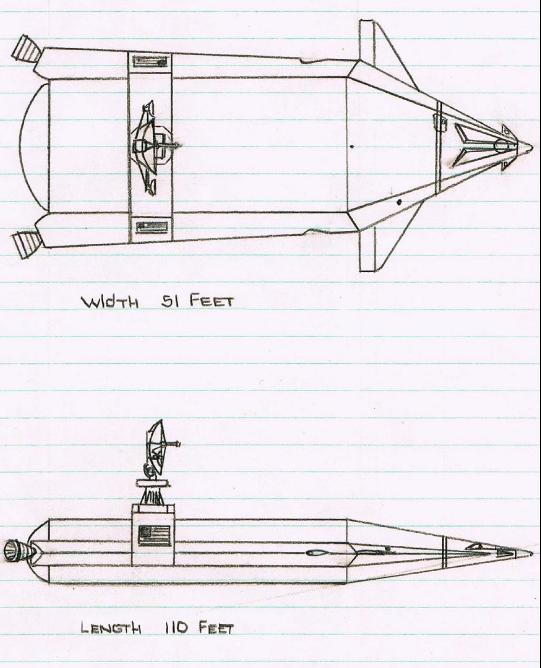 |
|||
Design 3: More details of the design, which included the addition of the side hatch first seen in "Escape From the Planet of the Apes." |
Design 3: The addition of the Orbital/Propulsion Module. Note the cross over to "2001: A Space Odyssey" with the addition of the Discovery's deep space antenna. |
|||
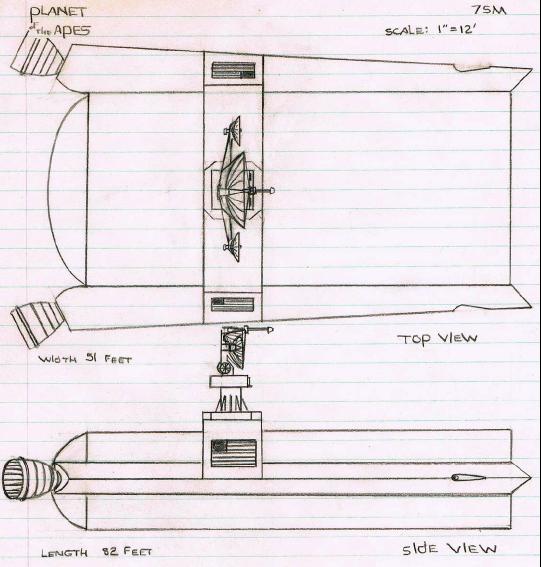 |
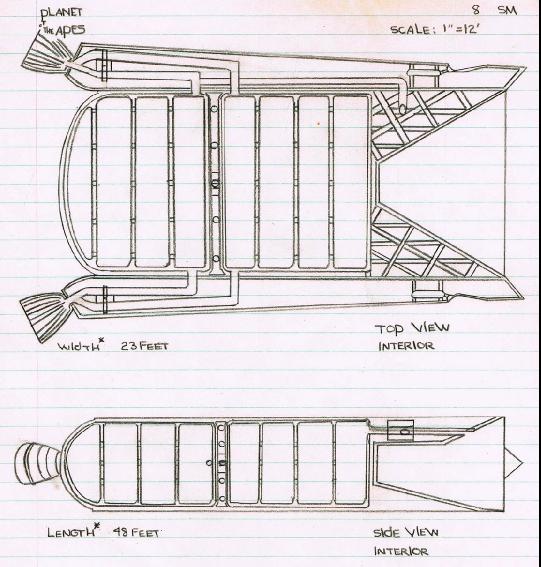 |
|||
Design 3: Exterior and cutaway views of the Orbital/Propulsion Module. Very simplistic, but it was an exciting exercise for a young kid with space on the brain. |
||
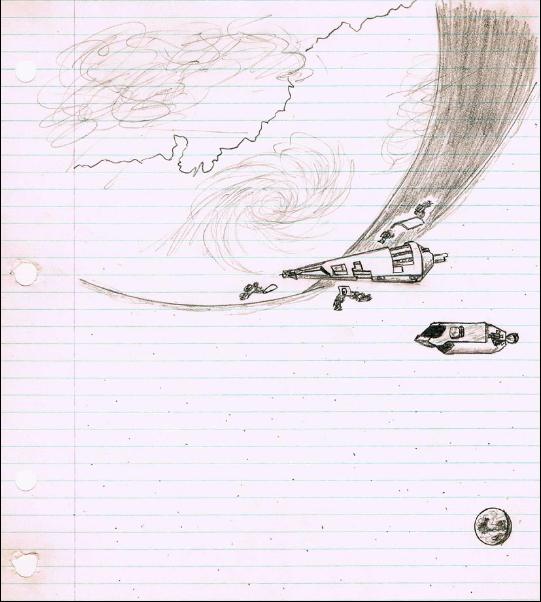 |
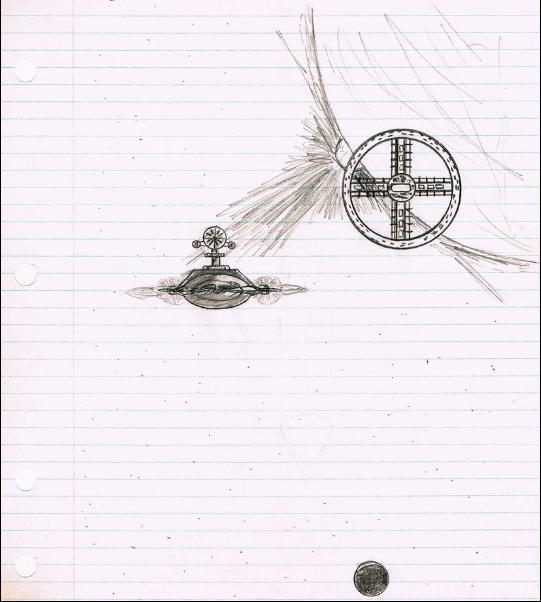 |
|||
1. On Orbit Construction. (Note that this series of artwork all use Design 3.) |
2. Leaving Orbit. (Note Space Station V from "2001: A Space Odyssey.") |
|||
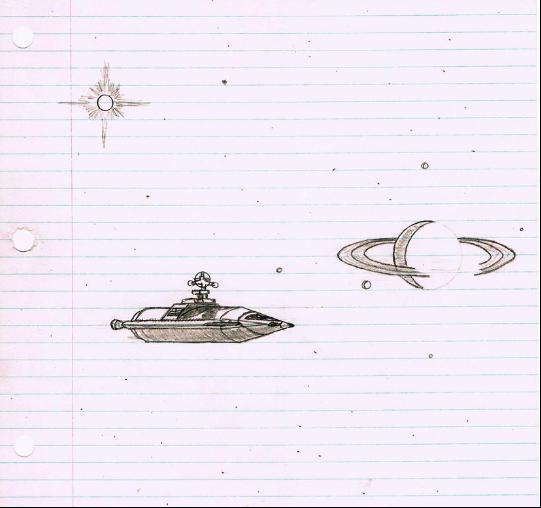 |
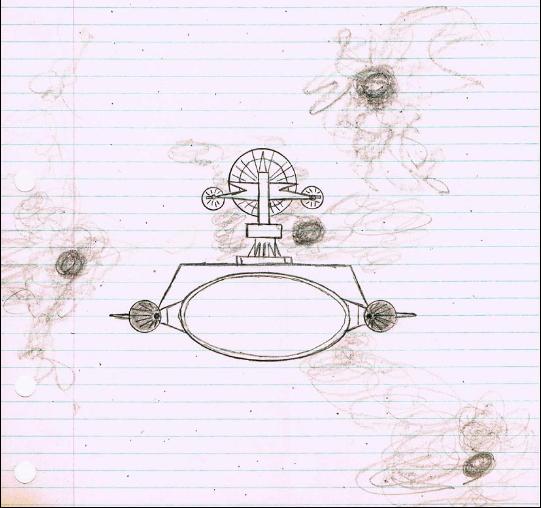 |
|||
3. System Exit. |
4. Bending Time. |
|||
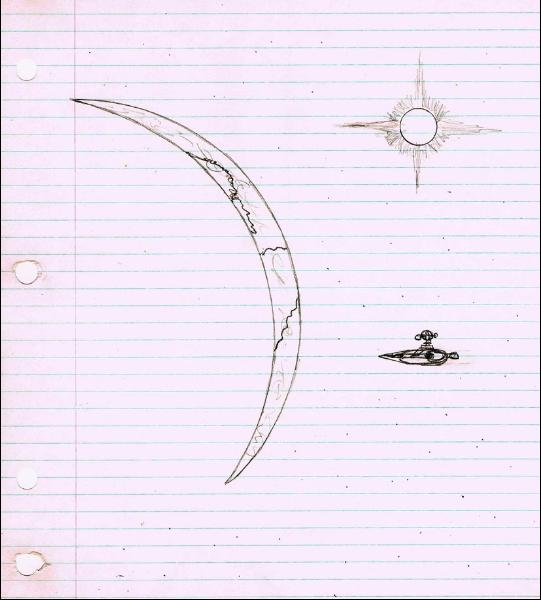 |
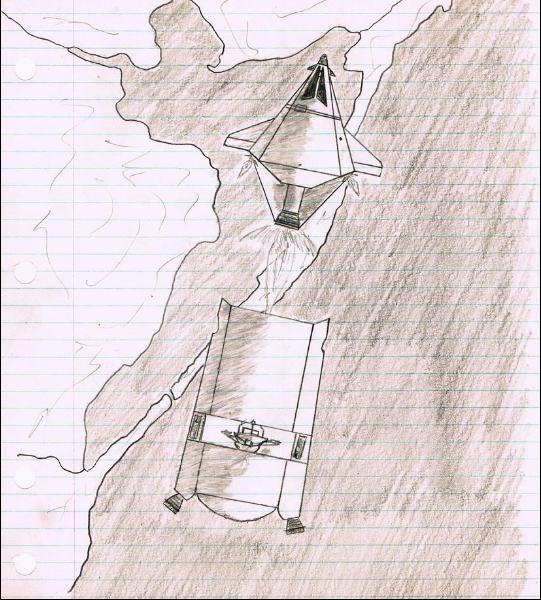 |
|||
5. Return. |
6. Separation. |
|||
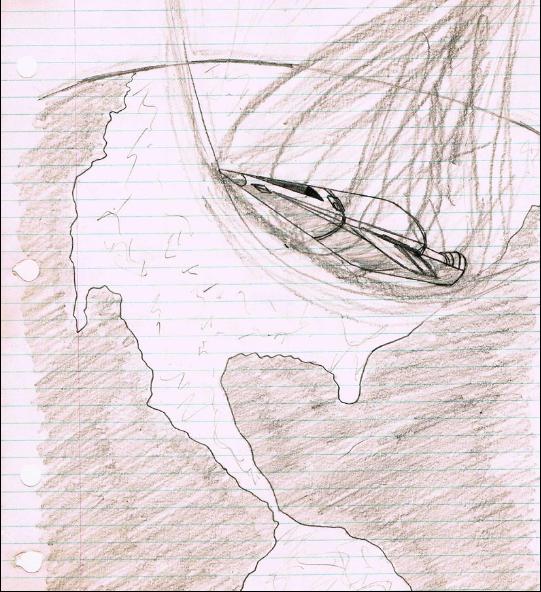 |
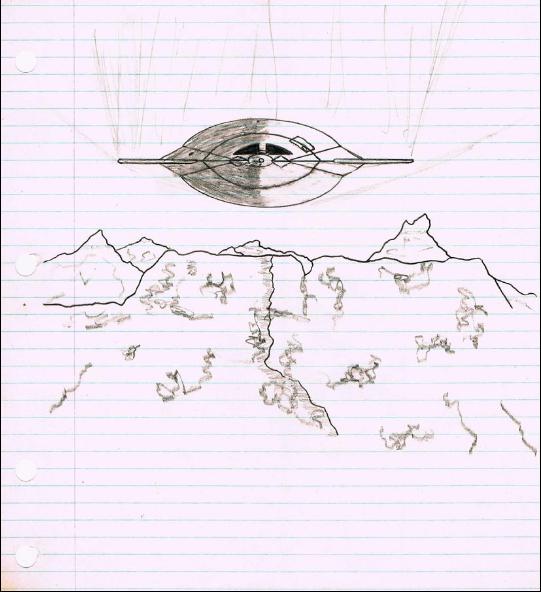 |
|||
7. Entry Interface (Note that lower Florida has gone under water). |
8. Descent-1: Over the Forbidden Zone. |
|||
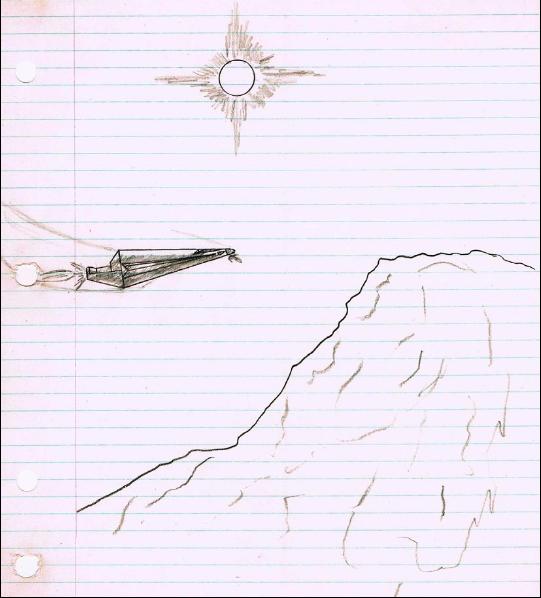 |
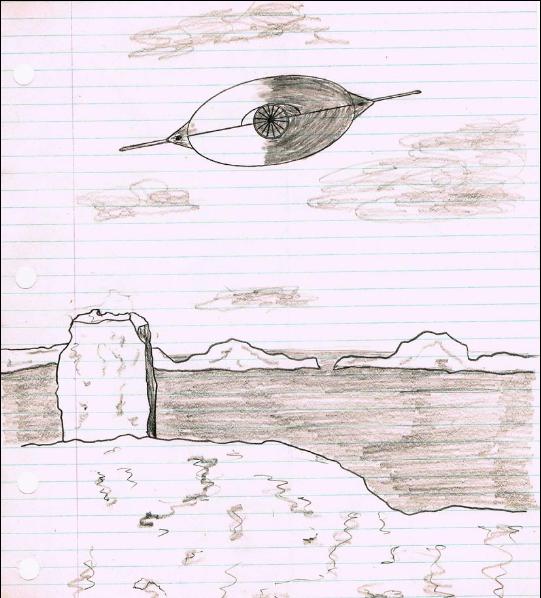 |
|||
9. Descent-2: Maneuvering. |
10. Descent-3: Approaching the Inland Sea. |
|||
 |
||
11. Crash Landing. |
||
Note that my skills as an artist are extremely limited. What Phil Broad produced was light years ahead of anything I ever created, so please be sure to check out his work. It should never be forgotten. |
||
